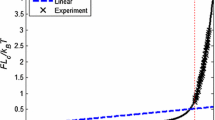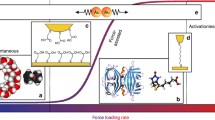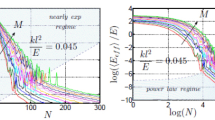Abstract
We study thermally activated unzipping, which is modeled as a debonding process. The system is modeled as a parallel bundle of elastically interacting breakable units loaded through a series spring. Using equilibrium statistical mechanics, we compute the reversible response of this mechanical system under quasi-static driving. Depending on the stiffness of the series spring, the system exhibits either ductile behavior, characterized by noncooperative debonding, or brittle behavior, with a highly correlated detachment of the whole bundle. We show that the ductile to brittle transition is of the second order and that it can also be controlled by temperature.











Similar content being viewed by others
References
Kanninen, M., Popelar, C.: Advanced Fracture Mechanics. Oxford University Press, Oxford (1985)
Brenner, S.S.: Mechanical behavior of sapphire whiskers at elevated temperatures. J. Appl. Phys. 33, 33 (1962)
Selinger, R.L.B., Wang, Z.-G., Gelbart, W.M.: Statistical-thermodynamic approach to fracture. J. Chem. Phys. 95, 9128 (1991)
Cook, R.F., Liniger, E.G.: Kinetics of indentation cracking in glass. J. Am. Ceram. Soc. 76, 1096 (1993)
Petrov, V.A., Orlov, A.N.: Statistical kinetics of thermally activated fracture. Int. J. Fract. 12, 231 (1976)
Xing, X.-S.: Nonequilibrium statistical theory of thermally activated delayed fracture. Eng. Fract. Mech. 38, 1 (1991)
Berdichevsky, V., Le, K.C.: On the microcrack nucleation in brittle solids. Int. J. Fract. 133, L47 (2005)
K. K. a. A. S. Krausz, Fracture Kinetics of Crack Growth, 1st ed., Mechanical Behavior of Materials 1 (Springer Netherlands, 1988)
Pomeau, Y.: Brisure spontanée de cristaux bidimensionnels courbés. C. R. Acac. Sci. Paris Serie II , 553 (1992)
Ciliberto, S., Guarino, A., Scorretti, R.: The effect of disorder on the fracture nucleation process. Phys. D: Nonlinear Phenom. 158, 83 (2001)
Politi, A., Ciliberto, S., Scorretti, R.: Failure time in the fiber-bundle model with thermal noise and disorder. Phys. Rev. E 66, 026107 (2002)
Bell, G.: Models for the specific adhesion of cells to cells. Science 200, 618 (1978)
Schwarz, U.S., Safran, S.A.: Physics of adherent cells. Rev. Mod. Phys. 85, 1327 (2013)
Evans, E., Ritchie, K.: Dynamic strength of molecular adhesion bonds. Biophys. J. 72, 1541 (1997)
Chakrabarti, B., Nelson, D.R.: Shear unzipping of DNA. J. Phys. Chem. B 113, 3831 (2009)
Hyeon, C., Thirumalai, D.D.: Minimal models for the structure and dynamics of nucleic acids. Mol. Model. At. Scale: Methods Appl. Quant. Biol. 141 (2014)
Mishra, R.K., Modi, T., Giri, D., Kumar, S.: On the rupture of DNA molecule. J. Chem. Phys. 142, 174910 (2015)
Bergues-Pupo, A.E., Bergues, J.M., Falo, F., Fiasconaro, A.: Thermal and inertial resonances in DNA unzipping. Eur. Phys. J. E 38, 41 (2015)
Strunz, T., Oroszlan, K., Schäfer, R., Güntherodt, H.-J.: Dynamic force spectroscopy of single DNA molecules. Proc. Natl. Acad. Sci. 96, 11277 (1999)
Helenius, J., Heisenberg, C.-P., Gaub, H.E., Muller, D.J.: Single-cell force spectroscopy. J. Cell Sci. 121, 1785 (2008)
Friedrichs, J., Helenius, J., Muller, D.J.: Quantifying cellular adhesion to extracellular matrix components by single-cell force spectroscopy. Nat. Protoc. 5, 1353 (2010)
Gonzalez-Rodriguez, D., Bonnemay, L., Elgeti, J., Dufour, S., Cuvelier, D., Brochard- Wyart, F.: Detachment and fracture of cellular aggregates. Soft Matter 9, 2282 (2013)
Hogan, B., Babataheri, A., Hwang, Y., Barakat, A.I., Husson, J.: Characterizing cell adhesion by using micropipette aspiration. Biophys. J. 109, 209 (2015)
Selinger, R.L.B., Wang, Z.-G., Gelbart, W.M., Ben-Shaul, A.: Statistical-thermodynamic approach to fracture. Phys. Rev. A 43, 4396 (1991)
Roux, S.: Thermally activated breakdown in the fiber-bundle model. Phys. Rev. E 62, 6164 (2000)
Scorretti, R., Ciliberto, S., Guarino, A.: Disorder enhances the effects of thermal noise in the fiber bundle model. EPL Europhys. Lett. 55, 626 (2001)
Alava, M.J., Nukala, P.K.V.V., Zapperi, S.: Statistical models of fracture. Adv. Phys. 55, 349 (2006)
Virgilii, A., Petri, A., Salinas, S.R.: A thermodynamical fibre bundle model for the fracture of disordered materials. J. Stat. Mech. Theory Exp. 2007, P04009 (2007)
Yoshioka, N., Kun, F., Ito, N.: Kinetic Monte Carlo algorithm for thermally induced breakdown of fiber bundles. Phys. Rev. E 91, 033305 (2015)
Erdmann, T., Schwarz, U.S.: Stability of adhesion clusters under constant force. Phys. Rev. Lett. 92, 108102 (2004)
Peyrard, M., Bishop, A.R.: Statistical mechanics of a nonlinear model for DNA denaturation. Phys. Rev. Lett. 62, 2755 (1989)
Manghi, M., Destainville, N.: Physics of base-pairing dynamics in DNA. Phys. Rep. 631, 1 (2016)
Vologodskii, A., Frank-Kamenetskii, M.D.: DNA melting and energetics of the double helix. Phys. Life Rev. (2017)
Erdmann, T., Albert, P.J., Schwarz, U.S.: Stochastic dynamics of small ensembles of non-processive molecular motors: the parallel cluster model. J. Chem. Phys. 139, 175104 (2013)
Caruel, M., Truskinovsky, L.: Physics of muscle contraction. Rep. Prog. Phys. 81, 036602 (2018)
Seifert, U.: Rupture of multiple parallel molecular bonds under dynamic loading. Phys. Rev. Lett. 84, 2750 (2000)
Erdmann, T., Schwarz, U.: Impact of receptor-ligand distance on adhesion cluster stability. Eur. Phys. J. E 22, 123 (2007)
Erdmann, T., Schwarz, U.S.: Bistability of cell-matrix adhesions resulting from nonlinear receptor-ligand dynamics. Biophys. J. 91, L60 (2006)
Huxley, A.F., Simmons, R.M.: Proposed mechanism of force generation in striated muscle. Nature 233, 533 (1971)
Seifert, U.: Dynamic strength of adhesion molecules: role of rebinding and self-consistent rates. EPL Europhys. Lett. 58, 792 (2002)
Kramers, H.: Brownian motion in a field of force and the diffusion model of chemical reactions. Physica 7, 284 (1940)
Hänggi, P., Talkner, P., Borkovec, M.: Reaction-rate theory: fifty years after Kramers. Rev. Mod. Phys. 62, 251 (1990)
Pradhan, S., Hansen, A., Chakrabarti, B.K.: Failure processes in elastic fiber bundles. Rev. Mod. Phys. 82, 499 (2010)
Hansen, A., Hemmer, P., Pradhan, S.: The Fiber Bundle Model: Modeling Failure in Materials, Statistical Physics of Fracture and Breakdown. Wiley, New Jersey (2015)
Batra, R.: Elements of Continuum Mechanics, AIAA education series (American Institute of Aeronautics & Astronautics, 2006)
Kreuzer, H.J., Payne, S.H.: Stretching a macromolecule in an atomic force microscope: statistical mechanical analysis. Phys. Rev. E 63, 021906 (2001)
Caruel, M., Truskinovsky, L.: Bi-stability resistant to fluctuations. J. Mech. Phys. Solids 109, 117 (2017)
Fuhrmann, A., Engler, A.J.: The cytoskeleton regulates cell attachment strength. Biophys. J. 109, 57 (2015)
Discher, D.E., Janmey, P., Wang, Y.-L.: Tissue cells feel and respond to the stiffness of their substrate. Science 310, 1139 (2005)
Yeung, T., Georges, P.C., Flanagan, L.A., Marg, B., Ortiz, M., Funaki, M., Zahir, N., Ming, W., Weaver, V., Janmey, P.A.: Effects of substrate stiffness on cell morphology, cytoskeletal structure, and adhesion. Cell Motil. 60, 24 (2004)
Jülicher, F., Prost, J.: Cooperative molecular motors. Phys. Rev. Lett. 75, 2618 (1995)
Delaplace, A., Roux, S., Jaudier Cabot, G.P.: Damage cascade in a softening interface. Int. J. Solids Struct. 36, 1403 (1999)
Campa, A., Dauxois, T., Ruffo, S.: Statistical mechanics and dynamics of solvable models with long-range interactions. Phys. Rep. 480, 57 (2009)
Caruel, M., Truskinovsky, L.: Statistical mechanics of the Huxley-Simmons model. Phys. Rev. E 93, 062407 (2016)
Balian, R.: From microphysics to macrophysics: methods and applications of statistical physics, theoretical and mathematical physics. Springer, Berlin (2007)
Puglisi, G., Truskinovsky, L.: Cohesion-decohesion asymmetry in geckos. Phys. Rev. E 87, 032714 (2013)
Sheshka, R., Recho, P., Truskinovsky, L.: Rigidity generation by nonthermal fluctuations. Phys. Rev. E 93, 052604 (2016)
Acknowledgements
The authors thank R. Garcia-Garcia for helpful discussions. H.B.R. was supported by a Ph.D. fellowship from Ecole Polytechnique; L. T. was supported by the French Government under the Grants ANR-10-IDEX-0 0 01-02 PSL and ANR-17-CE08-0 047-02.
Author information
Authors and Affiliations
Corresponding author
Additional information
Publisher's Note
Springer Nature remains neutral with regard to jurisdictional claims in published maps and institutional affiliations.
Rights and permissions
About this article
Cite this article
da Rocha, H.B., Truskinovsky, L. Equilibrium unzipping at finite temperature. Arch Appl Mech 89, 535–544 (2019). https://doi.org/10.1007/s00419-018-1485-4
Received:
Accepted:
Published:
Issue Date:
DOI: https://doi.org/10.1007/s00419-018-1485-4




